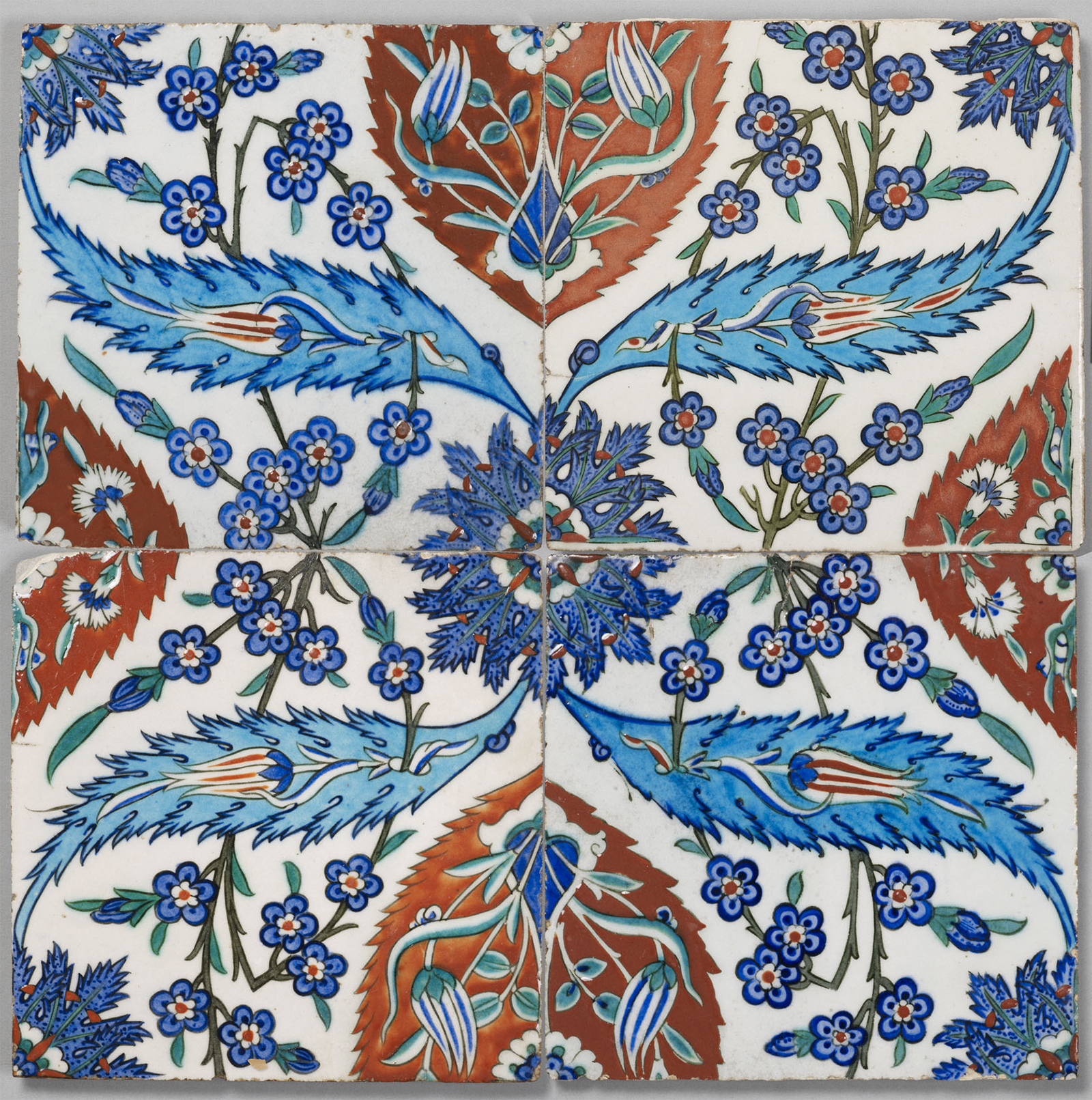Click on the image to zoom
Panel of Four Tiles
- Accession Number:AKM878
- Place:Turkey, Iznik
- Dimensions:48 cm x 48 cm
- Date:1580
- Materials and Technique:Fritware, underglazed and painted
The small city of Iznik near Constantinople (present-day Istanbul, Turkey) produced ceramics with frit-based bodies. Iznik’s stature as a ceramics centre grew in international importance under the royal patronage of the Ottoman sultans. Later, Iznik wares became more commercial with the introduction of items for everyday domestic use. The most brilliant early examples from the 15th century have blue-and-white decorations of delicate arabesques, graceful branches in bloom, rumis, and palmettes on a white slip. During the 16th century, other colours and motifs were added, especially red and bold emerald green as well as naturalistic flowers such as tulips, carnations, and roses with centred saz leaves.
This panel assembled from four tiles creates a complete repeating composition that would have covered an entire wall. Almond-shaped compartments filled with flowers, a rose bud, tulips, and carnations are enclosed by curved serrated leaves (saz leaves), each with a tulip on its surface and connecting border rosettes. The leaves are interwoven with branches of blossoming plum-tree, [1] some of which are bent and pass through perforations in the serrated leaves.
The Victoria and Albert Museum in London, UK has in its collection a panel of 24 tiles. [2] This panel was brought to London from the baths at the shrine complex of Abu Ayyub al-Ansari, known in Turkish as Eyüp Ensari, who was one of the companions of prophet Mohammad. His final resting place became an important pilgrimage destination. Damage sustained from an earthquake in the 19th century required that the complex be extensively renovated and reconstructed. Many tiles with identical design appeared on the Western market, while some of the tiles remained in situ at the complex. The Aga Khan Museum tiles may have derived from this complex, if we rule out the possibility that they were the result of over production, as suggested by Walter Denny. [3]
- Filiz Çakır Phillip
Notes
1. The blossom of the plum-tree, prunus, likely entered the decorative lexicon of Ottoman artisans through their Iranian counterparts, who had in turn been inspired by Chinese porcelain. See Nurhan Atasoy and Julian Raby, Iznik: The Pottery of Ottoman Turkey (London: Alexandria Press, 1989), 223.
2. Victoria & Albert Museum, London, UK, Acc. No. 401-1900. https://collections.vam.ac.uk/item/O90733/tile-panel-unknown/. Similar panels can be found in Musée du Louvre, Paris, OA3919-2-247, ex-collection of Albert Sorlin-Dorigny, 1895; David Collection, Copenhagen, Acc. No. 41/1968; The Calouste Gulbenkian Collection, Lisbon has a panel with 10 tiles, Acc. No. 1709; Metropolitan Museum of Art, New York has a single tile, Acc. No. 64.27.17.
3. See Walter B. Denny, Iznik: The Artistry of Ottoman ceramics (London: Thames & Hudson, 2004), 208–10.
References
Atasoy, Nurhan and Julian Raby. Iznik: The Pottery of Ottoman Turkey. London: Alexandria Press, 1989. ISBN:9781856690546
Denny, Walter B. Iznik: The Artistry of Ottoman ceramics. London: Thames & Hudson, 2004. ISBN: 9780500517888
Note: This online resource is reviewed and updated on an ongoing basis. We are committed to improving this information and will revise and update knowledge about this object as it becomes available.


